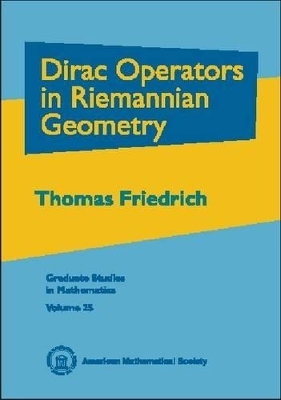
For a Riemannian manifold $M$, the geometry, topology and analysis are interrelated in ways that are widely explored in modern mathematics. Bounds on the curvature can have significant implications for the topology of the manifold. The eigenvalues of the Laplacian are naturally linked to the geometry of the manifold. For manifolds that admit spin (or $\textrm {spin}^\mathbb{C}$) structures, one obtains further information from equations involving Dirac operators and spinor fields. In the case of four-manifolds, for example, one has the remarkable Seiberg-Witten invariants.In this text, Friedrich examines the Dirac operator on Riemannian manifolds, especially its connection with the underlying geometry and topology of the manifold. The presentation includes a review of Clifford algebras, spin groups and the spin representation, as well as a review of spin structures and $\textrm {spin}^\mathbb{C}$ structures. With this foundation established, the Dirac operator is defined and studied, with special attention to the cases of Hermitian manifolds and symmetric spaces. Then, certain analytic properties are established, including self-adjointness and the Fredholm property. An important link between the geometry and the analysis is provided by estimates for the eigenvalues of the Dirac operator in terms of the scalar curvature and the sectional curvature.Considerations of Killing spinors and solutions of the twistor equation on $M$ lead to results about whether $M$ is an Einstein manifold or conformally equivalent to one. Finally, in an appendix, Friedrich gives a concise introduction to the Seiberg-Witten invariants, which are a powerful tool for the study of four-manifolds. There is also an appendix reviewing principal bundles and connections. This detailed book with elegant proofs is suitable as a text for courses in advanced differential geometry and global analysis, and can serve as an introduction for further study in these areas. This edition is translated from the German edition published by Vieweg Verlag.
| ISBN: | 9780821820551 |
| Publication date: | 30th August 2000 |
| Author: | |
| Publisher: | American Mathematical Society |
| Format: | Hardback |
| Series: | Graduate Studies in Mathematics |
| Genres: |
Differential and Riemannian geometry Calculus and mathematical analysis |